Kyoto Bucket List: 3 Days in Japan’s Cultural Hub + Day Trip Guide
Welcome to Kyoto, Japan’s cultural capital! In this fast-paced and walkable itinerary, prepare to see Kyoto’s most notable historical sites and wander the picturesque cobblestone streets. Known for Buddhist temples, gardens, shrines, and wooden houses, Kyoto is a city that will live up to your expectations. Enjoy this list of things to do in Kyoto during a 3-day stay, plus 2 day-trip options.
Table of Contents
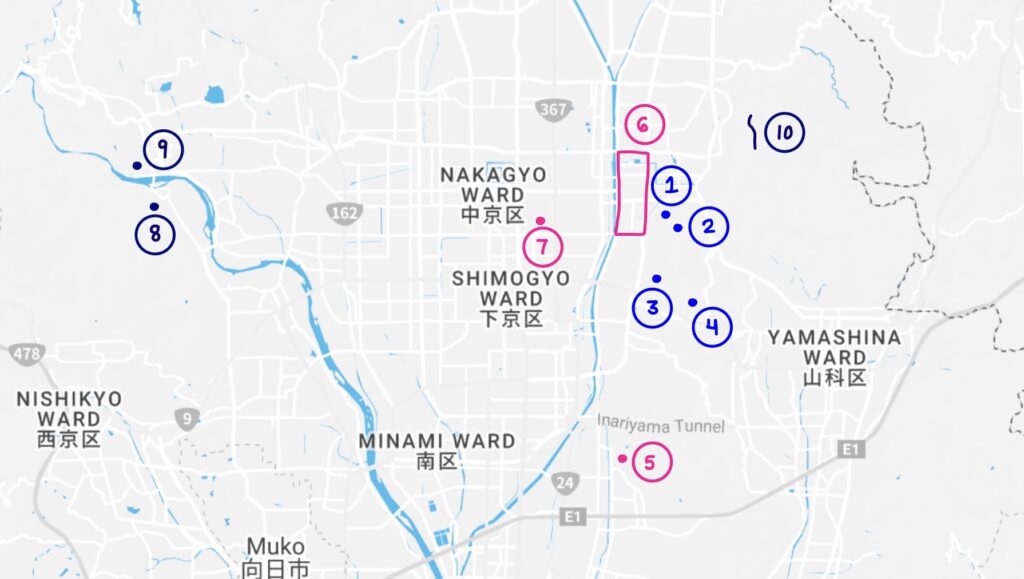
Day 1
On Day 1, let’s start exploring Kyoto on the famous Eastern side of the city. We took a free three-hour walking tour with Kyoto Localized and loved the way they guided the route. They help you hit a lot of items on your Kyoto bucket list.
(1) Chion-in
Chion-in is a beautiful temple in Kyoto where it is said that one of the schools of Buddhism was born. It now serves as the headquarters of this sect (Jodo-shu) and is home to a vast compound of gardens and wooden buildings.
(2) Maruyama Park
Maruyama Park is Chion-in’s backyard, and if you’re visiting Kyoto during the short-lived cherry blossom season, this is the best place to see them. Even if it isn’t cherry blossom season, Maruyama Park offers the opportunity to see wildlife, ponds, and vibrant plant life.
(3) Yasaka Pagoda
Our next destination, Yasaka Pagoda, is a famous landmark which you’ve probably seen in photos. This 5-story pagoda is even more impressive in person and is the last structure remaining from a temple complex built in the 6th century, known as the Hokan-ji Temple. This was the first pagoda we saw in Japan, and it was certainly a remarkable building.
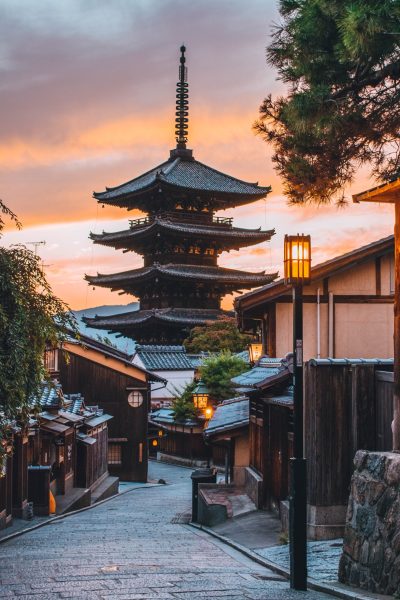
(4) Kiyomizu Dera
Next, wind through the busy cobblestoned streets in the direction of Kiyomizu Dera. Along the way, feel free to stop for a snack or souvenir shopping. This Buddhist temple complex has been around for over 1,000 years and is one of the city’s premier World Heritage sites (of which there are many!) for your Kyoto bucket list.
Day 2
(5) Fushimi Inari Shrine
Today, wake up a little bit earlier than usual to beat the crowds at the Fushimi Inari Shrine. This shrine is well-known for its thousands of gates that create a network of trails all around the main buildings. Make sure to wait to take your picture! While you may be overwhelmed by the sheer number of people sluggishly making their way through the tunnel of gates, keep trekking and everyone will thin out eventually. If you dare make it to the top of the mountain, it’s only about 40 minutes, but the climb is completely up steep stairs. To be honest, there is no view at the top, but it’s a grand feat to reach the highest shrine and is a perfect addition to your Kyoto bucket list.
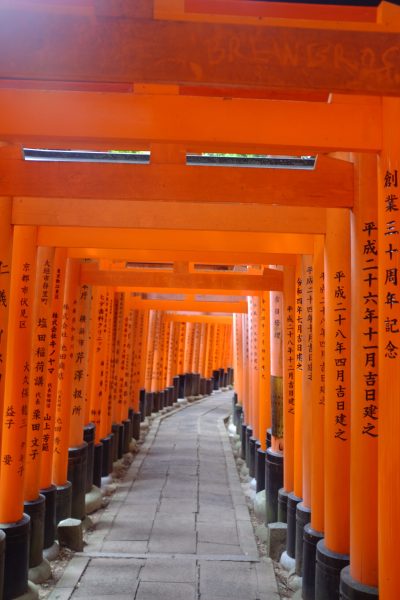
(6) Gion Neighborhood
Next, head to the neighborhood of Gion to walk around the narrow and historic streets. This is the district most known for geisha sightings, which tend to occur at night. The picturesque wooden houses are commonplace in the area, and if lucky, you may even catch a wedding photoshoot of a happy couple in traditional clothing.
(7) Downtown Kyoto
By now, you’ve probably become familiar with the beautiful Kamo River which is a center point of downtown Kyoto. Even though you might get eaten alive by mosquitos around this area, spend some time walking around Kyoto’s downtown where you will find plentiful restaurants, shops, cafes, and more. If you are visiting Kyoto in the summer, you will notice that all of the restaurants along the river have elevated terraces built on wooden slats.
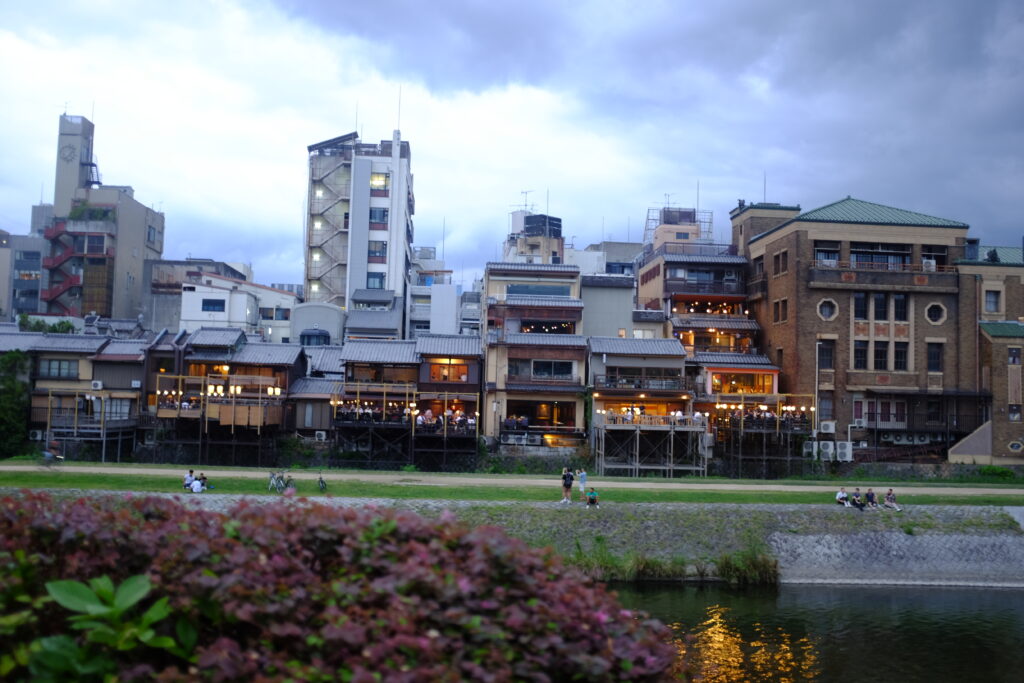
Day 3
Finally, it’s time to explore the Northwestern part of Kyoto, in a district called Arashiyama.
(8) Iwatayama Monkey Park
Our favorite stop in Arashiyama was the Iwatayama Monkey Park. This park sits atop a hill where the monkeys run freely. The park has done a great job keeping the monkeys free while making sure they don’t approach people. Unlike other nature parks where monkeys will come up to you demanding food, you are only allowed to feed them if you are in a “cage”. Therefore, they know not to attack you for food if you are wandering around the park, leading to an awesome synergy between the humans and monkeys.
(9) Arashiyama Bamboo Grove
Located only a close walk from the Monkey Park, the Arashiyama Bamboo Grove is an impressive forest of dense bamboo trees. This naturally occurring grove has a man-made pathway cutting through it, and while it only takes about 10 minutes to walk the entirety of the bamboo forest, it’s worth every moment.
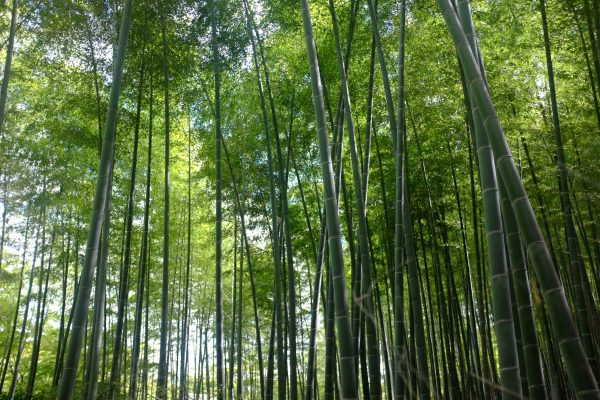
(10) Path of Philosophy
Finally, take a walk down the Path of Philosophy which follows a cherry-blossom-lined canal for about 1 kilometer. This stone path provides a picturesque walk to stretch your legs and admire the canal.
While the Path of Philosophy is often noted as being one of the best activities in Kyoto, we actually didn’t go. It’s important to note that it’s located a bit far from the center of Kyoto and bears a striking resemblance to the tiny Takase River in the downtown area. We chose to stay close to home and explore our own canal, but that doesn’t mean you shouldn’t add the Path of Philosophy to your Kyoto bucket list!
Special #1: Day Trip to Nara
I simply could not recommend this day trip more. Just 45 minutes away by train is Nara, a beautiful town known for its massive deer population. 1,200 very friendly deer call Nara Park home, and it will be nearly impossible to miss them. For only 200 yen, you can purchase crackers to feed the deer. Do beware! The deer get super excited about the crackers and will swarm you. While this is a fun experience, some of them do bite.
Nara Park is not just about the deer. It is also home to countless shrines that are well worth a visit. Our top two were the Great Buddha Hall, home to a giant Buddha from 1,300 years ago, and Kasuga Shrine, a complex lined with stone lanterns (and of course, deer!).
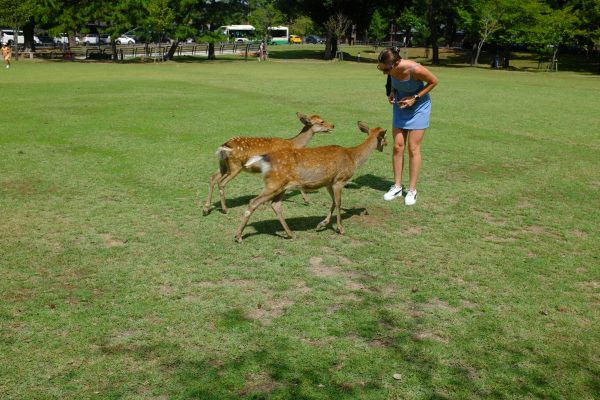
Special #2: Day Trip to Hiroshima
For a less cheery but necessary day trip experience, consider taking the bullet train from Kyoto to Hiroshima. While the journey lasts 2 hours and isn’t incredibly close, Hiroshima’s main sites are all viewable in a single afternoon.
I think it goes without saying that everyone should pay their respects at the Peace Memorial Park. Most famously, the epicenter of the atomic bomb still stands in the form of the derelict Hiroshima Prefectural Industrial Promotion Hall. Because the explosion occurred directly above this building, it retained its shape and now stands as a harrowing reminder of the atrocities of the bomb.
Take some time to visit the museum as well. While the images in this exhibition are not suitable for children, they show the graphic truth of the effects of the atomic bomb dropped in Hiroshima.
Food to Eat
Now what is travel without trying all the amazing food that Kyoto has to offer? While you certainly can’t pass over traditional Japanese food such as sushi and ramen, Kyoto is known for its own delicious menu, including, but certainly not limited to:
1. Yuba and Cheese – this fantastic crunchy and chewy food is tofu skin served on a stick. While yuba itself is not very flavorful, try the version with cheese for a deep-fried snack
2. Tofu – famous in Kyoto! It is supposedly the best in Japan due to Kyoto’s special water.
3. Wagyu – if you eat meat, you must try wagyu beef. While it costs hundreds of dollars when imported to other countries, Wagyu comes from Kobe, a town just 30 minutes from Kyoto. Therefore, not only is the meat fresh, but it is cheap(er)!
4. Sake – this fermented rice beverage is a popular alcoholic drink in Japan, originally from Kobe as well. Sip this liquor in a small cup and enjoy.
5. Yatsuhasi – now on to dessert, Yatushashi is a popular triangular sweet made from mochi and sugar and most commonly filled with red bean paste.

That’s all for Kyoto! We hope you enjoyed this Kyoto bucket list of things to do in Japan’s cultural capital. In this fast-paced itinerary, you can see the city in 3 days, but of course, feel free to spend more time exploring narrow alleyways and countless shrines. If you’re adding Tokyo to your Japan trip, check out our guide on 12 Things to Do in Tokyo in 4 Days, and our other Asian destination guides!
Happy sampling!

